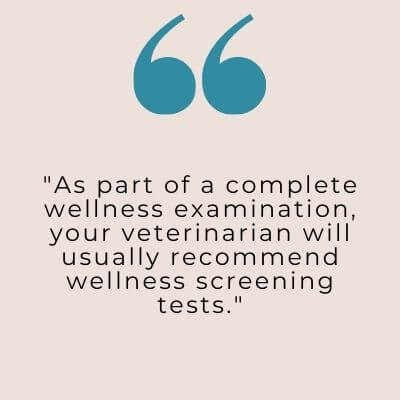What Is A Wellness Examination?
A wellness examination is a routine medical examination of a pet who appears healthy, as opposed to an examination of a pet who is ill. A wellness examination may also be called a ‘check-up’ or a ‘physical examination’. The focus of a wellness examination is the maintenance of optimal health.
How Often Should My Pet Have A Wellness Examination?
The answer to this question depends on your pet’s age and current health status. During early life, wellness exams are recommended monthly, while for the average adult pet, annual wellness examinations are the norm, and semi-annual examinations are recommended for middle-aged, senior, and geriatric pets.
Pets age at a faster rate than people. In one calendar year, a pet may age the equivalent of four to sixteen years in a human’s life. The reason for this dramatic difference is that puppies and kittens reach maturity very quickly and are essentially adolescents or young adults by one year of age; therefore, they are considered to be the equivalent of 15 or 16 years old by their first birthday. During the second year, the rate of aging slows down a little so that your pet will be the equivalent of about 24 or 25 years old by their second birthday. After that, the rate of aging stabilizes.
Your veterinarian is in the best position to recommend how often your pet should have a wellness examination based on its age, lifestyle, and health status.
What Will My Veterinarian Check During A Wellness Examination?
During a routine wellness examination, your veterinarian will ask you questions about your pet’s diet, exercise, thirst, breathing, behavior, habits, lifestyle, and general health. Your veterinarian will also perform a physical examination. Based on your pet’s history and physical examination, your veterinarian will then make recommendations for specific preventive medicine treatments, such as vaccination, parasite control, nutrition, skin and coat care, joint health, weight management, or dental care.
What Does My Veterinarian Check During A Physical Examination?
A physical examination involves observing the general appearance of your pet, listening to their chest (heart and lungs) with a stethoscope (auscultation), and feeling specific areas of the body (palpation), such as the lymph nodes, throat, legs, and the abdomen, and feeling your pet’s pulse.
Your veterinarian will observe or inspect your pet’s general level of alertness and interest in its surroundings, its general body and muscle condition, the haircoat and skin, eyes, ears, nose, face, mouth, and teeth.
What Else Might Be Checked During A Wellness Examination?
 Your veterinarian will recommend that a fresh sample of your pet’s feces be collected prior to the wellness examination. This sample will be processed and microscopically evaluated for the presence of parasite eggs. Your veterinarian may also recommend heartworm testing if you live in an area where there is a high incidence of this parasitic disease.
Your veterinarian will recommend that a fresh sample of your pet’s feces be collected prior to the wellness examination. This sample will be processed and microscopically evaluated for the presence of parasite eggs. Your veterinarian may also recommend heartworm testing if you live in an area where there is a high incidence of this parasitic disease.
As part of a complete wellness examination, your veterinarian will usually recommend wellness screening tests. There are four main categories of wellness testing recommended for pets: complete blood count (CBC), biochemistry profile, urinalysis, and thyroid hormone testing. Within each category, your veterinarian will advise you about how extensive the testing should be.
In younger pets without noticeable health complaints, relatively simple testing may be adequate; however, for older pets, additional wellness screening tests may include chest or abdominal radiographs (X-rays) to assess the size and appearance of the internal organs, such as the heart, lungs, kidneys, and liver, or radiographs of the skeletal system to look for degenerative changes in the bones or joints.
Why Are These Additional Tests Recommended?
Pets cannot tell you how they are feeling, and as a result, disease may be present before you are aware of it. To further complicate matters, as part of their survival instincts, most pets will hide signs of disease in the early stages. This means that a health condition may become highly advanced before your pet shows any obvious or recognizable problems. Some early warning signs may be detected by your veterinarian during the physical examination, or subtle changes that are suggestive of underlying issues may be found, prompting recommendations for further testing.
If a disease or condition can be detected before your pet shows obvious signs of illness, steps can often be taken to manage the problem before irreversible damage occurs, and the prognosis for a successful outcome improves. In addition, early detection and treatment are often less costly than waiting until a disease or problem becomes advanced enough to affect your pet’s quality of life.
Wellness examinations and testing are particularly important in senior and geriatric pets since there is a greater chance that underlying disease may be present. This is the reason why semi-annual examinations are recommended for senior pets.
Is There Anything I Need To Do To Prepare My Pet For A Wellness Examination?
When you book the appointment, you should ask whether you should fast your pet before the visit. Also, you should ask whether fresh urine or fecal sample is needed.
Prepare yourself with some basic information, such as the brand and type of food that your pet eats, whether your family feeds any table scraps, whether you give your pet any supplements, and whether anyone in the family has noticed any problems. This is also the time that you should take note of any concerns you might have and make inquiries into optimal health maintenance strategies for your furry friend.

